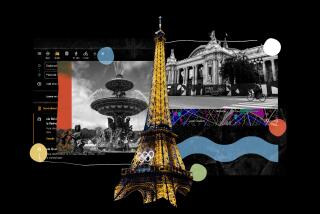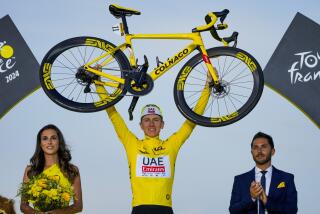Villages Rock as Tour Rolls
- Share via
The traveling Super Bowl that is the Tour de France begins today, 2,087 miles of cycling through rain, bitter cold, 100-degree heat and just about any type of obstacle imaginable -- be it fatigue-induced or real.
The Tour is more than a race, really, and it is about more than Lance Armstrong’s striving for a record sixth victory.
It is perhaps the world’s biggest road show, one that will pack up and move to a new town, village or city each night between now and July 25.
It is a caravan of some 5,000 cyclists, coaches, trainers, advertising trucks, mechanics, cooks and media from around the world driving 1,500 cars, trucks, vans, trailers and motorcycles. Or hovering overhead in helicopters.
It is a march through some of the most beautiful country in the world.
And it is not at all about eating cheese or drinking wine.
In each village where the Tour starts and stops, an army of workers sets up another little city for the nearly 200 cyclists, the 2,200 technicians, the 1,400 journalists and countless administrators and bureaucrats.
At each stop, a newsroom is set up with telephones, televisions, fax machines and copiers, to help the 35 television channels, 400 newspapers and dozens of radio networks. The newsrooms are sometimes tents, sometimes in city buildings, sometimes in grade-school cafeterias. Wherever there is an empty space.
The thousands of race fans who line the course each day often pitch tents and camp out for a few days in anticipation of the cyclists whizzing by their spot. No matter that the riders, when they arrive, will be in a manic pack in which it is nearly impossible to identify an individual.
If there is a perk for these devoted fans, it is the arrival of the publicity caravan.
On race day, a parade of garish vehicles, equipped with loudspeakers spewing techno music and scantily dressed women posing on hoods and roofs, snakes along the route.
Some of the publicity vans are designed as hot dogs, a French version of the Oscar Mayer Wienermobile. One looks like a giant water bottle.
They are moving advertisements for water, candy, soda, energy drinks, chocolate drinks, and auto and cycling companies. People, many of them college students, toss trinkets, candy, bottled water (particularly prized), plastic key chains, hunks of cheese and sausage (also popular), cheap caps and towels from the vehicles. The fans, fueled by coffee, beer and boredom, occasionally fight each other for the stuff.
At each start village there is a festival. The idea at first was to create a place where athletes, officials and media could gather to share notes and stories, perhaps over a croissant and coffee before the day begins. Now, the Village Depart has become a corporate event, with lots of champagne flowing.
Most of the riders hide in their trailers. Most of the journalists wander in search of one fresh quote.
There are two rest days during the 22-day race, but hardly anyone involved in the race uses them to rest.
Parking lots overflow with cycling team trailers, and the clank of tools and the smell of cigarettes are evident throughout the night as mechanics oil parts, work on tires and wash the cycles, the tools and the trucks.
Perhaps most unusual, the riders ride on these “off days.” As Armstrong’s main trainer Chris Carmichael said, a body can’t rest in the middle of a 2,500-mile race. Not if that body is going to climb on a bike the next day for another 150-mile ride.
“The chemistry of the body means that if Lance didn’t take a ride for a day in the race then he’d have a very hard time getting on the bike when the race restarts,” Carmichael said last year.
The racers finish about 4 p.m. each day. They usually ride into a small town to find a gridlock of team trailers, TV trucks and sweaty reporters trying to locate the U.S. Postal red, white and blue colors or the T-Mobile pink trailer so they can fight and push their way close enough to the barrier that separates media from the cyclists.
The teams and their trucks get escorted out of town quickly and off to the hotels where they will spend the night.
On a Saturday last year in Saint Girons, a small Pyrenees town, the U.S. Postal truck was parked in front of a tiny inn of 18 rooms.
The truck filled up the street. Local traffic had to drive on the sidewalk to pass.
When Armstrong exited the truck, dozens of fans stood silently on the sidewalk. Mostly they stared. Armstrong walked quickly into the hotel.
The team ate together in a single room and hotel guests watched them through an open window.
Riders spend most nights being massaged and treated for muscle aches and pains.
Only then do they sleep.
*
(BEGIN TEXT OF INFOBOX)
RACE FACTS
What: The Tour de France, competitive cycling’s premier race.
When: Beginning today, with the Prologue (a time trial in Liege, Belgium) and ending on July 25 on the Champs-Elysees in Paris.
What: A series of 20 stage races of various lengths for a field of 189 cyclists over 22 days, ranging from a time trial of 9.3 miles at stage 16 to the 147.2-mile run from Limoges to Saint Flour at stage 10, with standings based on each cyclist’s cumulative time.
Defending champion: Lance Armstrong, of the United States Postal Service team, who will be seeking a record sixth championship.
More to Read
Sign up for Essential California
The most important California stories and recommendations in your inbox every morning.
You may occasionally receive promotional content from the Los Angeles Times.













